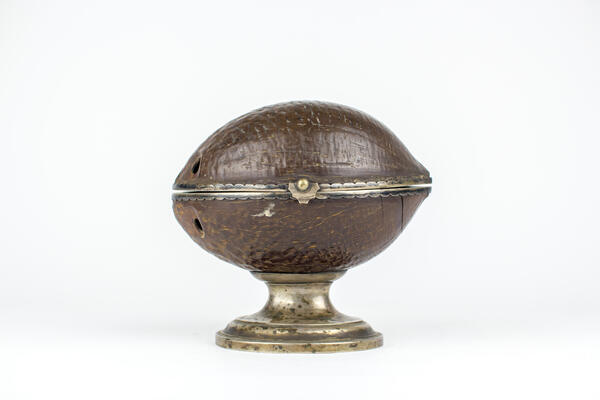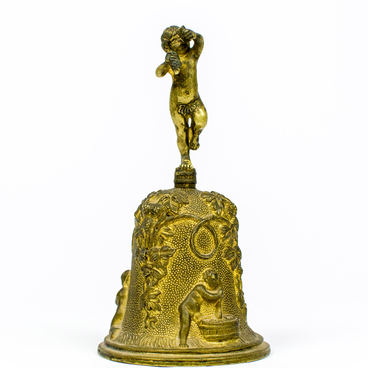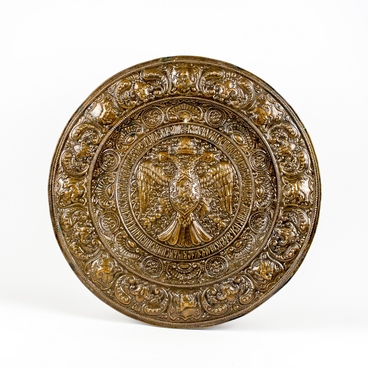The casket presented in the exhibition is made of a coconut set in metal. The nut is divided into two equal parts: the upper one acts as a lid, which reclines and closes with a metal latch. The box stands on an oval-shaped metal stand. The nut itself is attached to the base with a screw.
Sailors began to supply exotic coconuts to Europe in the period of Great Geographical Discoveries, 15th — 17th centuries. Coconuts were brought with jewelry, aromatic oils, spices, ivory, and other expensive goods.
The first decorative pieces made of coconut appeared in Europe in the 16th century. They were highly valued at that period. At that time, artisans used various natural materials for making expensive dishes, for example, ostrich eggs or seashells. In Russia, coconuts were called “Indian nuts”, since they were brought mainly from India.
It is believed that jewel boxes originated from ladies' chests, popular in the Middle Ages. In such chests, ceremonial clothes, valuable dishes, and jewelry were stored. Over time, people made wardrobes for clothes, but jewelry continued to be kept in chests with their size decreased.
Jewel caskets were usually locked. In the 16th — 17th centuries, boxes were made with a hiding place in the thickness of the lid or under a false bottom. In the 19th century, there were boxes with a secret that could be opened only with the help of a specific sequence of actions, for example, clicking on different sections.
The word “Shkatula” in the Russian language was first mentioned in 1598 and “Shkatulka” in 1610. It comes from the Polish, Middle Latin, and Italian languages and means “a box”. The cost of the casket depended on the material from which it was made. For example, caskets made of ivory or precious metals, covered with enamel, leather, precious or semi-precious stones, were highly valued. Boxes were often decorated with engraving, inlaying, filigree or cloisonné enamel.
Sailors began to supply exotic coconuts to Europe in the period of Great Geographical Discoveries, 15th — 17th centuries. Coconuts were brought with jewelry, aromatic oils, spices, ivory, and other expensive goods.
The first decorative pieces made of coconut appeared in Europe in the 16th century. They were highly valued at that period. At that time, artisans used various natural materials for making expensive dishes, for example, ostrich eggs or seashells. In Russia, coconuts were called “Indian nuts”, since they were brought mainly from India.
It is believed that jewel boxes originated from ladies' chests, popular in the Middle Ages. In such chests, ceremonial clothes, valuable dishes, and jewelry were stored. Over time, people made wardrobes for clothes, but jewelry continued to be kept in chests with their size decreased.
Jewel caskets were usually locked. In the 16th — 17th centuries, boxes were made with a hiding place in the thickness of the lid or under a false bottom. In the 19th century, there were boxes with a secret that could be opened only with the help of a specific sequence of actions, for example, clicking on different sections.
The word “Shkatula” in the Russian language was first mentioned in 1598 and “Shkatulka” in 1610. It comes from the Polish, Middle Latin, and Italian languages and means “a box”. The cost of the casket depended on the material from which it was made. For example, caskets made of ivory or precious metals, covered with enamel, leather, precious or semi-precious stones, were highly valued. Boxes were often decorated with engraving, inlaying, filigree or cloisonné enamel.



